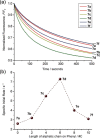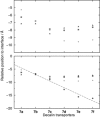Tilting and Tumbling in Transmembrane Anion Carriers: Activity Tuning through n-Alkyl Substitution
- PMID: 26748870
- PMCID: PMC5064602
- DOI: 10.1002/chem.201504057
Tilting and Tumbling in Transmembrane Anion Carriers: Activity Tuning through n-Alkyl Substitution
Abstract
Anion transport by synthetic carriers (anionophores) holds promise for medical applications, especially the treatment of cystic fibrosis. Among the factors which determine carrier activity, the size and disposition of alkyl groups is proving remarkably important. Herein we describe a series of dithioureidodecalin anionophores, in which alkyl substituents on one face are varied from C0 to C10 in two-carbon steps. Activities increase then decrease as the chain length grows, peaking quite sharply at C6 . Molecular dynamics simulations showed the transporter chloride complexes releasing chloride as they approach the membrane-aqueous interface. The free transporter then stays at the interface, adopting an orientation that depends on the alkyl substituent. If chloride release is prevented, the complex is positioned similarly. Longer chains tilt the binding site away from the interface, potentially freeing the transporter or complex to move through the membrane. However, chains which are too long can also slow transport by inhibiting movement, and especially reorientation, within the phospholipid bilayer.
Keywords: anion transport; lipophilicity; membranes; molecular dynamics; supramolecular chemistry.
© 2016 WILEY-VCH Verlag GmbH & Co. KGaA, Weinheim.
Figures






Similar articles
-
Application of Lipophilic Balance Modification in the Creation of Potent Synthetic Anionophores.Mini Rev Med Chem. 2017;17(14):1398-1405. doi: 10.2174/1389557517666170206152330. Mini Rev Med Chem. 2017. PMID: 28176626 Review.
-
Supramolecular Transmembrane Anion Transport: New Assays and Insights.Acc Chem Res. 2018 Aug 21;51(8):1870-1879. doi: 10.1021/acs.accounts.8b00264. Epub 2018 Jul 31. Acc Chem Res. 2018. PMID: 30063324 Review.
-
Small molecule anionophores promote transmembrane anion permeation matching CFTR activity.Sci Rep. 2018 Feb 8;8(1):2608. doi: 10.1038/s41598-018-20708-3. Sci Rep. 2018. PMID: 29422673 Free PMC article.
-
Anthracene Bisureas as Powerful and Accessible Anion Carriers.Chemistry. 2018 Apr 20;24(23):6262-6268. doi: 10.1002/chem.201800508. Epub 2018 Apr 6. Chemistry. 2018. PMID: 29493830 Free PMC article.
-
Substituent effects of fluorinated bambusurils on their anion transport.Org Biomol Chem. 2025 Apr 16. doi: 10.1039/d5ob00400d. Online ahead of print. Org Biomol Chem. 2025. PMID: 40235442 Free PMC article.
Cited by
-
Reversible photo-control over transmembrane anion transport using visible-light responsive supramolecular carriers.Chem Sci. 2020 Jun 4;11(24):6325-6331. doi: 10.1039/d0sc02745f. eCollection 2020 Jun 28. Chem Sci. 2020. PMID: 32953027 Free PMC article.
-
Squaramide-based ion pair receptors can facilitate transmembrane transport of KCl and zwitterions including highly polar amino acids.Chem Sci. 2025 Mar 18;16(16):6982-6990. doi: 10.1039/d5sc00866b. eCollection 2025 Apr 16. Chem Sci. 2025. PMID: 40134660 Free PMC article.
-
Transmembrane anion transport mediated by halogen bonding and hydrogen bonding triazole anionophores.Chem Sci. 2020 Apr 15;11(18):4722-4729. doi: 10.1039/d0sc01467b. Chem Sci. 2020. PMID: 34122927 Free PMC article.
-
Multistate Redox-Switchable Ion Transport Using Chalcogen-Bonding Anionophores.J Am Chem Soc. 2023 Feb 1;145(4):2661-2668. doi: 10.1021/jacs.2c12892. Epub 2023 Jan 18. J Am Chem Soc. 2023. PMID: 36652378 Free PMC article.
-
Photoswitchable Bis(amidopyrroles): Modulating Anion Transport Activity Independent of Binding Affinity.J Org Chem. 2023 Aug 4;88(15):11328-11334. doi: 10.1021/acs.joc.3c01018. Epub 2023 Jul 13. J Org Chem. 2023. PMID: 37440304 Free PMC article.
References
LinkOut - more resources
Full Text Sources
Other Literature Sources

